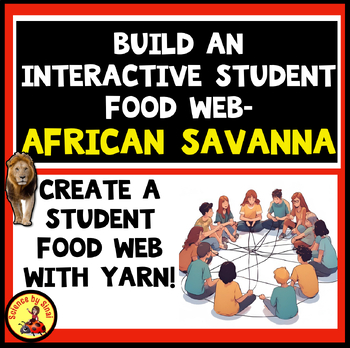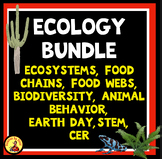Build an Interactive STUDENT FOOD WEB! Food Chain Activity AFRICAN SAVANNA
- PPTX
What educators are saying
Also included in
- 8 interactive products having to do with the ecology and energy flow of the AFRICAN SAVANNA food webs and chains, along with events affecting the biodiversity of the savanna ecosystem. Please visit the preview. Turn your classroom into a giant food web and then follow through with a digital or priPrice $22.50Original Price $28.00Save $5.50
- Here is a mega bundle with 47 engaging food web, food chain and biodiversity activities in 6 ecosytems which are ocean, deciduous forest, rainforest, tundra, African savanna and desert. Each ecosystem bundle begins with my best selling food web student yarn activity and several activities that echoPrice $152.00Original Price $190.00Save $38.00
- After teaching science for over 30 years, I finally put together my middle school and upper elementary ecology and environmental science, ecosystems, food chains and webs, biodiversity, Earth Day, STEM and CER resources! Click on the preview for complete details!The resources range from interactivePrice $252.60Original Price $315.75Save $63.15
- Here is a bundle of 6 student interactive food chain and food web activities to interpret interactions and energy flow between producers and consumers. Each of the six products contains 16-19 images of plants and animals and students use yarn to interconnect the food chains with the entire class inPrice $26.50Original Price $32.50Save $6.00
- Using the plants and animals of the African savanna safari to first create a giant food web using yarn and students, and then a reinforcement activity with students using a digital drag and drop method to create food chains.Please see the previews of each product. Are you looking for other science rPrice $7.20Original Price $9.00Save $1.80
- Three products with fun, interactive food web and chains activities using plants and animals from the African Savanna Safari. Create a giant classroom web with your students, draw a food web and drag and drop food chains to see the energy flow. Please see the previews for each product.If you have anPrice $10.00Original Price $12.50Save $2.50
Description
Here is an African savanna safari student interactive food chain and food web activity to interpret interactions and energy flow between producers and consumers. Using 18 images of plants and animals, the students use yarn to interconnect food chains with the entire class in this exciting activity!
This set of pages can be used for several activities that include concepts about food chains, food webs, consumers vs. producers, the different levels of consumers, herbivores vs. carnivores vs. omnivores and autotrophs vs. heterotrophs. There is also a page on savanna destruction, due to farming, to have the discussion started about what happens to the entire ecosystem when part of it is damaged.
I have used this activity for third graders all the way up through 6th grade with fun results.
There are 18 Illustrated slides and each consumer has a list of who it eats and who eats it. For the lower classes you may have to prompt them with that information but with the older classes I tend to let them figure it out themselves.
Included with this set are the directions for several different activities that you can use with the materials. The food chains are mapped out for the teacher and detailed directions are given for how to create the food web with the children sitting in a circle on the floor with yarn. What better way to have the students learn this important
What’s included in this resource:
- 18 plant or animal images with a second page that includes what the organism eats and what eats it
- List of included food chains
- 16 Key Terms
- ”Pollution” page
- Chart to classify organisms into producers, 1st consumers, 2nd consumers or top predators
- Reflection Questions
Check out my other food web and food chain activities.
Rainforest Jungle Food Web activity
DIGITAL INTERACTIVE FOOD WEB ACTIVITY 5-LS2 and MS-LS2-3
FOOD CHAIN DIGITAL ACTIVITY Drag and Drop DISTANCE LEARNING
Food Web Biodiversity Dice Game
Are you looking for other science resources? NGSS aligned activities? Science classroom decor or clip art? Please check out the rest of my store at SCIENCE BY SINAI.
https://www.teacherspayteachers.com/Store/Science-By-Sinai
Follow Me
Do you want to be the first to find out when I post a new resource? Please click on the green star next to my name to FOLLOW MY STORE, SCIENCE BY SINAI, and to get an email each time I post a new product. As a follower you will also get notifications of freebies and sales!
Check me out on social media.
https://www.pinterest.com/karensinai2/
https://www.instagram.com/sciencebysinai/
https://www.facebook.com/Science-by-Sinai
Feedback
**Did you know that you can save money on TpT resources by leaving feedback? Go to your “My Purchases“ page and leave feedback on the resources you’ve purchased to earn TpT credits!
Copyright.
Each purchase is a license for ONE person to use in a classroom setting. It is a violation for individuals, schools and districts to redistribute, edit, sell, or post this item on the Internet or to other individuals. Disregarding the copyright is a violation of the Digital Millennium Copyright Act and subject to legal action. By purchasing this product you acknowledge that you have read and understood these terms of use.











